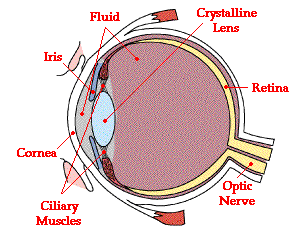Hold down the T key for 3 seconds to activate the audio accessibility mode, at which point you can click the K key to pause and resume audio. Useful for the Check Your Understanding and See Answers.
The human eye is a complex anatomical device that remarkably demonstrates the architectural wonders of the human body. Like a camera, the eye is able to refract light and produce a focused image that can stimulate neural responses and enable the ability to see. In Lesson 6, we will focus on the physics of sight. We will use our understanding of refraction and image formation to understand the means by which the human eye produces images of distant and nearby objects. Additionally, we will investigate some of the common vision problems that plague humans and the customary solutions to those problems. As we proceed through Lesson 6, we will apply our understanding of refraction and lenses to the physics of sight.
The eye is essentially an opaque eyeball filled with a water-like fluid. In the front of the eyeball is a transparent opening known as the cornea. The cornea is a thin membrane that has an index of refraction of approximately 1.38. The cornea has the dual purpose of protecting the eye and refracting light as it enters the eye. After light passes through the cornea, a portion of  it passes through an opening known as the pupil. Rather than being an actual part of the eye's anatomy, the pupil is merely an opening. The pupil is the black portion in the middle of the eyeball. Its black appearance is attributed to the fact that the light that the pupil allows to enter the eye is absorbed on the retina (and elsewhere) and does not exit the eye. Thus, as you sight at another person's pupil opening, no light is exiting their pupil and coming to your eye; subsequently, the pupil appears black.
it passes through an opening known as the pupil. Rather than being an actual part of the eye's anatomy, the pupil is merely an opening. The pupil is the black portion in the middle of the eyeball. Its black appearance is attributed to the fact that the light that the pupil allows to enter the eye is absorbed on the retina (and elsewhere) and does not exit the eye. Thus, as you sight at another person's pupil opening, no light is exiting their pupil and coming to your eye; subsequently, the pupil appears black.
Like the aperture of a camera, the size of the pupil opening can be adjusted by the dilation of the iris. The iris is the colored part of the eye - being blue for some people and brown for others (and so forth); it is a diaphragm that is capable of stretching and reducing the size of the opening. In bright-light situations, the iris adjusts its size to reduce the pupil opening and limit the amount of light that enters the eye. And in dim-light situations, the iris adjusts so as to maximize the size of the pupil opening and increase the amount of light that enters the eye.
Light that passes through the pupil opening, will enter the crystalline lens. The crystalline lens is made of layers of a fibrous material that has an index of refraction of roughly 1.40. Unlike the lens on a camera, the lens of the eye is able to change its shape and thus serves to fine-tune the vision process. The lens is attached to the ciliary muscles. These muscles relax and contract in order to change the shape of the lens. By carefully adjusting the lenses shape, the ciliary muscles assist the eye in the critical task of producing an image on the back of the eyeball.
The inner surface of the eye is known as the retina. The retina contains the rods and cones that serve the task of detecting the intensity and the frequency of the incoming light. An adult eye is typically equipped with up to 120 million rods that detect the intensity of light and about 6 million cones that detect the frequency of light. These rods and cones send nerve impulses to the brain. The nerve impulses travel through a network of nerve cells. There are as many as one million neural pathways from the rods and cones to the brain. This network of nerve cells is bundled together to form the optic nerve on the very back of the eyeball.
Each part of the eye plays a distinct part in enabling humans to see. The ultimate goal of such an anatomy is to allow humans to focus images on the back of the retina. This task is discussed in the next part of Lesson 6.